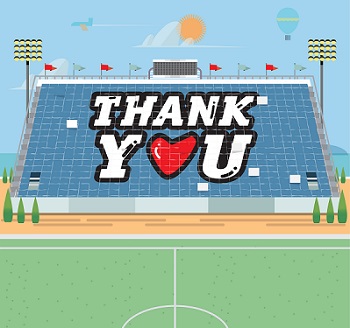| Back to Back Issues Page |
 |
|
Useful Community Plus February 18, 2021 |
You can't let your work on behalf of your community descend into dreary drudgery.
If this is happening to you, change your thinking--and your language.
First, it's about the thinking. Once upon a time when I was discouraged with an organization, I said to someone in a similar group that I didn't feel like my contributions were doing any good. Then I surprised myself by saying maybe it's like a stadium card stunt, where we just can't see that the letters we are holding up are part of something bigger than ourselves.
Years later, I recognize it's exactly like that. In your community work, you're holding up the S in MISSISSIPPI in the stadium, and you just can't see the end result. Without you, something would be mis_ing.
Second, it's about the language. We were struck by a good article from
Fast Company about words and phrases to stop using in 2021. Regarding community work, we focused on their suggestion to substitute "get to" for "should" or "have to."
Think of it. Instead of having to confront an obnoxious parade committee member, you get to reimagine how your neighborhood association plans the parade!
Instead of having to spend another Saturday morning painting stuff in the business district, you get to paint flower boxes purple!
Instead of saying to yourself you should complain to city hall yet again about your neighbor, maybe for the fourth or fifth time, today you get to help a code inspector understand the impact on your neighborhood!
This reframing really isn't just happy talk for the sake of perking
up February. It helps your brain relearn the habit of joyful discovery. In the process, you will stay more engaged and banish boredom.
By staying aware of your thinking and language, you can help others flourish as they too appreciate that they are part of something bigger than themselves.
You might be interested in one of these:
Why eviction matters from the Eviction Lab, a great resource for this topic
Here's a new report on community development capital for small and mid-size cities
The impact of cleaning up vacant buildings on crime
Alley house ("laneway") development in Edmonton
This month we finished our three-part series on Big Ideas in community development. This latest piece on the intersection between public health and community development explores how the two topics are related, and concludes with some suggestions about how you can incorporate the rediscovery of their connection into your neighborhood organizations and other civic work. We also substantially revised and added to our page about rural neighborhoods, giving some advice about organizing for success in a rural setting, information about the worthwhile Rural Community Solutions resource, and taking better advantage of our own website. (In case you missed it, the other big ideas articles give an overview of racial equity and community development and climate change and community planning.) In the last month we posted answers to these visitor questions: Steps in a community diagnosis project Difference between regeneration and redevelopment Who regulates CDCs (community development corporations)? How often do cities update their zoning maps? How to stop construction on vacant land next door How to change property considered commercial to residential Do housing codes violate civil rights? What is abolitionist housing policy? Are parks in a separate zoning district? Too much regulation of boat docks The next monthly email will arrive on a Thursday in March. Feel free to forward this email to a friend to encourage them to subscribe. Your replies to this e-mail are most welcome. We only exist to serve, so your feedback will be valuable. |
| Back to Back Issues Page |



